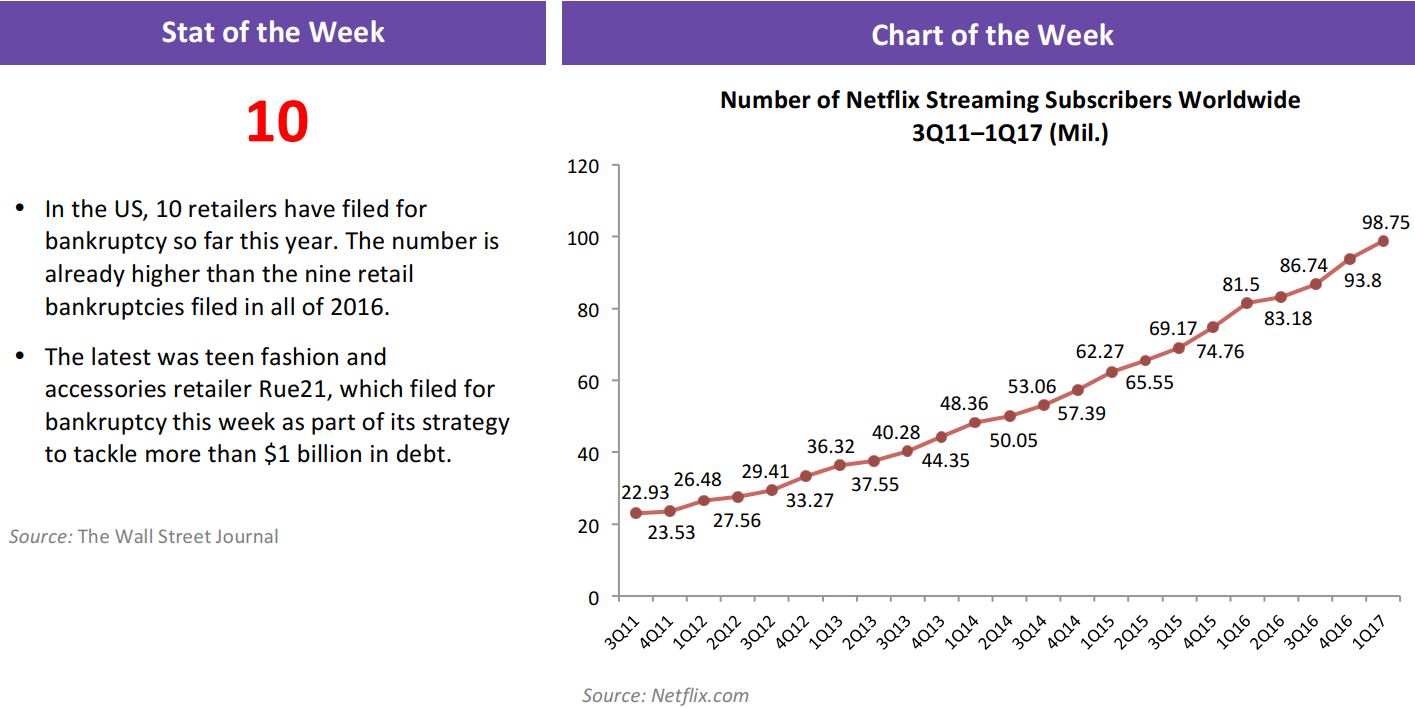
From the Desk of Deborah Weinswig
The Shipping Wars are Heating Up!
Last week, Amazon reduced its free-shipping minimum to $25. This is the second time this year the Seattle retailer has moved to reduce the minimum order value eligible for free shipping. Last week’s policy change comes after Walmart reduced
its own free-shipping minimum to $35 and Target’s move to
raise its free-shipping minimum to $35 from $25.
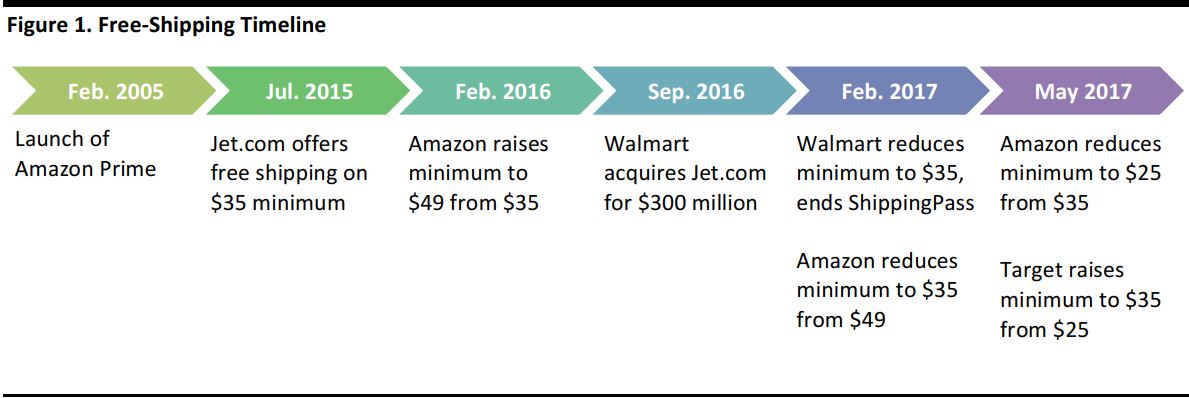
Source: CNNMoney.com/Engadget.com/MarketWatch.com/Memphis Business Journal
The free-shipping incentive war was originally sparked with the 2005 launch of Amazon Prime, through which Amazon audaciously began offering free shipping (on selected items) for subscribers paying a $99 annual fee. Those Prime members receive an ever-growing list of services, such as free streaming video, free songs, photo storage and access to the latest services, such as one- and two-hour delivery and use of the Alexa intelligent agent.
Shipping minimums oscillated from that point onward, and many retailers offered free shipping during the holidays (at various minimums) to remain competitive.
Subsequent to the launch of Prime, the number of subscribers and features grew steadily, prompting Amazon to proclaim the first Prime Day holiday in 2015, which offered free trial memberships and deals exclusively for Prime members. Prime Day 2016 was even bigger, with Amazon announcing that orders increased by 60% worldwide and by 50% in the US. Consumer Intelligence Research Partners most recently estimated that Amazon has 80 million Prime members in the US, accounting for nearly half of US households. Given this figure and the ways that Prime membership locks in members through convenience, services and access to exclusive hardware platforms, Amazon is clearly challenging other retailers to respond.
The brief lifetime of Jet.com further inflamed the shipping wars. Jet initially launched as a type of online warehouse club, offering free shipping with a $35 minimum purchase. However, the company quickly dropped plans for a membership fee. Following Walmart’s acquisition of Jet.com in September 2016, Walmart adopted many of Jet’s policies (and it put Jet’s management team in charge of its online business), echoing Jet in offering free shipping with a $35 purchase in February 2017.
Despite its status as a titan of e-commerce, Amazon surprisingly matched Walmart’s offer of free shipping with a $35 purchase in February 2017 and then sweetened its own offer to a $25 minimum in May. Thus, the battle line has been redrawn at a $25 minimum purchase for free shipping. As of the time of writing, Walmart has not seen fit to match Amazon’s offer. One fundamental difference between the two companies is that Amazon’s shareholders seem to tolerate its paucity of profitability in exchange for rapid growth. Amazon could possibly offer free shipping across the board, and its shareholders would likely accept the lower profitability, whereas Walmart’s shareholders seem to be more traditional and focused on seeing earnings-per-share growth.

US RETAIL EARNINGS

Source: Company reports
US RETAIL & TECH HEADLINES
 Here is One of the Few Bright Spots in Retail
(May 16) CNBC.com
Here is One of the Few Bright Spots in Retail
(May 16) CNBC.com
- Home Depot dodged the woes of the struggling US retail industry in the first quarter, helped by Americans plowing more money into fixing up their houses. Earnings handily topped analysts’ estimates in the quarter and the company boosted its forecast. The retailer also said that sales so far this quarter have been “very good.”
- Home Depot, the largest US home-improvement retailer, is profiting from the rebound in housing prices, which has made owners more willing to revamp their properties because they see them as a sound investment. That has helped Home Depot avoid a broader retail malaise in which falling mall traffic and online shopping have weighed on the industry’s results.
 Amazon Has a Tech Team Focused on Helping Customers Find Clothes that Fit Perfectly
(May 16) CNBC.com
Amazon Has a Tech Team Focused on Helping Customers Find Clothes that Fit Perfectly
(May 16) CNBC.com
- Amazon has been quietly assembling a team of people to build technology that could one day help you find shoes and clothes that fit just right. Should the technology become available, it would be another way Amazon is reinventing retail with machine learning.
- Sam Dwarakanath, Senior Manager of Software Engineering at Amazon, described the effort, saying, “I am building and leading a technical team that is focused on making it easy for customers to discover apparel and shoes that appeal to them, including finding the perfect fit.” The final technology could involve taking a picture of a product with your phone, which would enable you to see how different sizes of the product would fit on you.
 Target’s New Online Strategy: Less is More
(May 15) The Wall Street Journal
Target’s New Online Strategy: Less is More
(May 15) The Wall Street Journal
- Target is narrowing its focus and rethinking its digital strategy, even as competitors such as Walmart invest heavily to diversify their online offerings.
- The Minneapolis-based retailer has revamped some e-commerce projects, eliminating an in-house startup and implementing new initiatives to save on shipping costs. It has also cut ties with digital partners such as Curbside in favor of developing its own programs, and walked away from prospective deals, including an Arizona grocery-store chain and online service Boxed.com, according to people familiar with the talks.
 US Retail Sales Rose by 0.4% in April, Versus a 0.6% Expected Increase
(May 12) CNBC.com
US Retail Sales Rose by 0.4% in April, Versus a 0.6% Expected Increase
(May 12) CNBC.com
- Americans stepped up their spending at auto dealers, hardware stores and e-commerce outlets in April as retail sales rebounded from two sluggish months. The US Commerce Department says that retail sales increased by 0.4% in April from March. Sales ticked up just 0.1% in March and fell in February.
- The increase suggests that consumers may spur faster growth in the April–June quarter after the economy barely expanded in the first three months of the year. The rise also indicates that the struggles of large retail chains such as Macy’s and JCPenney reflect changes in consumer buying patterns rather than broader economic weakness. Sales at department stores fell 0.2% in April.
 Amazon Makes Major Push into Furniture
(May 12) The Wall Street Journal
Amazon Makes Major Push into Furniture
(May 12) The Wall Street Journal
- com wants to furnish your home. The online retail giant is making a major push into furniture and appliances, including building at least four massive warehouses focused on handling bulky items, according to people familiar with Amazon’s plans.
- With that move, the Seattle-based retailer is taking on two companies that dominate online furniture sales—Wayfair and Pottery Barn owner Williams-Sonoma. Furniture is one of the fastest-growing segments of US online retail; in 2015, online furniture sales grew by 18%, second only to groceries, according to Barclays. About 15% of the $70 billion US furniture market has moved online, research firm IBISWorld says.
EUROPE RETAIL EARNINGS

The results of DIA China were presented as discontinued operations in 1Q17, in accordance with accounting standard IFRS 5, as the group “has initiated a process to explore strategic options for its activities in the region.” DIA did not publish the restated results for 1Q16, so our figures are inferred from growth rates.
Source: Company reports/Fung Global Retail & Technology
EUROPE RETAIL HEADLINES
 UK Footfall Grows at its Fastest Quarterly Rate in Five Years
(May 15) Press release
UK Footfall Grows at its Fastest Quarterly Rate in Five Years
(May 15) Press release
- UK retail footfall in April grew by 1.6%, according to the British Retail Consortium (BRC). The rate was above the three-month average of 0.7% and the fastest rate seen since February 2012.
- “Staycations” are believed to have boosted growth. BRC Chief Executive Helen Dickinson stated, “The inclusion of the holidays in this period will have distorted this figure, but even looking beyond this, the picture over the last quarter has been largely positive.”
 House of Fraser Announces New Chief Executive
(May 11) Company press release
House of Fraser Announces New Chief Executive
(May 11) Company press release
- British department store House of Fraser announced the appointment of Alex Williamson as Chief Executive Officer, effective July 31, 2017.
- Frank Slevin, Executive Chairman of House of Fraser, commented, “Alex is uniquely placed to execute our vision, and to contribute his extensive expertise of delivering compelling and engaging experiences for the customer.”
 LVMH Launches Multibrand Website
(May 11) RetailDetail.eu
LVMH Launches Multibrand Website
(May 11) RetailDetail.eu
- French luxury group LVMH will launch its own mulitbrand website, called 24Sevres.com, on June 6 in 70 countries. The site will cost “several million dollars,” according to the company, and will include both LVMH brands and third-party brands.
- Eric Goguey, General Director of 24Sevres.com, told French press agency AFP, “We will launch with a limited fall and summer collection, filled with about 70 brands’ products, but we will expand the website’s product range in September to about 150 brands.”
 Aldi Boss Reveals UK Expansion Plans
(May 12) RetailGazette.co.uk
Aldi Boss Reveals UK Expansion Plans
(May 12) RetailGazette.co.uk
- German supermarket chain Aldi could grow its UK store numbers to around 2,600. It currently has 700 stores in the UK, but is now looking to add up to eight stores in some British towns to challenge the dominance of Tesco and Sainsbury’s.
- Aldi Chief Executive Matthew Barnes told The Grocer, “We think not only could we have a store in every town and city, but for every 25,000 to 30,000 people.”
 Missguided Selects its Tech Partner for Brick-and-Mortar Stores
(May 12) Company press release
Missguided Selects its Tech Partner for Brick-and-Mortar Stores
(May 12) Company press release
- Global fashion brand Missguided has entered a strategic partnership with Intercity Technology to deliver and support the IT infrastructure for Missguided’s first physical shops.
- David Pollitt, Head of IT Operations at Missguided, said, “We aim to expand our brick-and-mortar estate across the UK and we’re looking forward to working in partnership with Intercity in order to support the customer’s shopping experience whilst Missguided continues to develop its multichannel experience.”
 Canada Goose to Open First European Store
(May 11) Company press release
Canada Goose to Open First European Store
(May 11) Company press release
- Canadian winter clothing retailer Canada Goose announced that it will open its first European flagship store in London this fall and that it will expand its e-commerce operations to seven new markets in Europe.
- After six decades as a manufacturer, the company became a retailer in 2014, when it launched it first e-commerce site in Canada. It expanded its e-commerce operations into the US in 2015, and the UK and France in 2016. Dani Reiss, President and CEO of Canada Goose, said of the expansion, “Opening our first European store is not only a milestone for Canada Goose, but it’s turning a dream into reality.”
ASIA TECH HEADLINES
 Xiaomi Puts the Focus on India with Plans to Open 100 Retail Stores
(May 12) TechCrunch.com
Xiaomi Puts the Focus on India with Plans to Open 100 Retail Stores
(May 12) TechCrunch.com
- Xiaomi has been increasing its office retail presence in China as it bids to gain ground stolen by rivals in its homeland, and now it is making that same push in its second-largest market, India. Xiaomi is introducing its Mi Home stores in India, starting with a debut space in Bengaluru that will open in just over a week.
- The company plans to expand to 100 stores in India over the next two years. Xiaomi passed $1 billion in revenue for the first time in India last year, and it ended 2016 as India’s second-highest-selling smartphone maker, behind only Samsung.
 Tencent Doubles Down on Game Studio Pocket Gems with $90 Million Investment
(May 11) TechCrunch.com
Tencent Doubles Down on Game Studio Pocket Gems with $90 Million Investment
(May 11) TechCrunch.com
- Chinese Internet giant Tencent has continued its recent investment spree by backing US-based game studio Pocket Gems to the tune of $90 million. Tencent invested in the company back in 2015, when it put in a reported $60 million for a 20% stake.
- Pocket Gems, which was founded in 2009, claims to have notched 300 million downloads to date, and its monetization efforts appear to be picking up steam. App analytics company Sensor Tower estimates that revenue for April reached $17.5 million, which, if maintained, would put the company on course to surpass $200 million in sales this year.
 Intel and Samsung Gang Up on Qualcomm, Backing FTC Monopoly Suit
(May 13) Bloomberg.com
Intel and Samsung Gang Up on Qualcomm, Backing FTC Monopoly Suit
(May 13) Bloomberg.com
- Samsung Electronics and Intel weighed in with their own gripes about Qualcomm while cheering on the US Federal Trade Commission’s (FTC’s) lawsuit accusing the chipmaker of trying to corner the market for semiconductors used in smartphones.
- South Korea–based Samsung, one of Qualcomm’s largest customers, and Intel, one of its biggest competitors, filed arguments in support of the FTC’s case against Qualcomm. Both contend that the San Diego–based company stops them from competing fairly against it by leveraging patents that cover the fundamentals of modern phone systems.
 Toshiba Set to Strike Back as Western Digital Clash Heats Up
(May 15) Bloomberg.com
Toshiba Set to Strike Back as Western Digital Clash Heats Up
(May 15) Bloomberg.com
- Toshiba is moving to block Western Digital employees from the flash-memory venture they share, as a threat of legal action looms over the increasingly bitter dispute over who gets to buy the Japanese company’s chip unit.
- The escalating standoff between the companies over the chip unit sale could imperil Toshiba’s plans to use cash from the divestment to plug a hole in its balance sheet from a massive loss in its nuclear power business.
LATAM RETAIL AND TECH HEADLINES
 Brazil Retail Sales Fall in March at Fastest Rate in 14 Years
(May 11) Reuters.com
Brazil Retail Sales Fall in March at Fastest Rate in 14 Years
(May 11) Reuters.com
- Retail sales in Brazil unexpectedly fell in March at the steepest monthly rate in 14 years, strengthening bets on a bolder interest rate cut at the end of this month. Sales volumes excluding cars and building materials fell by 1.9% in March from February. Economists polled by Reuters had forecast a decrease of 0.6%.
- Consumption has slumped, as a record 14 million Brazilians were unemployed after the country’s worst recession ever. The surprisingly weak performance of Brazilian commerce in March frustrated hopes of an imminent recovery after an extraordinary upward revision of the January results.
 Hitachi Data Systems Eyes Growth in Brazil
(May 10) ZDNet.com
Hitachi Data Systems Eyes Growth in Brazil
(May 10) ZDNet.com
- Hitachi Data Systems (HDS) is aiming to grow in Brazil, and the company has new leadership in place as well as plans to broaden business in the country to other areas beyond storage-related services. As part of its local strategy, HDS appointed a new country manager for its Brazil business who is charged with driving a threefold increase in local operations in the next three years.
- The executive’s key areas of expertise include data center management, cloud computing, SAP applications and business intelligence. As well as growing HDS’s operations in Brazil, her challenges will include educating the industry about the company’s repositioning in the market.
 Cabify Nets $100 Million to Take on Uber in Latin America, Reportedly Raising $400 Million More
(May 9) TechCrunch.com
Cabify Nets $100 Million to Take on Uber in Latin America, Reportedly Raising $400 Million More
(May 9) TechCrunch.com
- Cabify, a ride-sharing startup that operates in Latin America, Spain and Portugal, has raised just under $100 million in new funding, according to an SEC filing for Maxi Mobility, as the company is officially called.
- The money is reportedly part of a total of $500 million that the company hopes to raise in a series D round. Cabify last raised $120 million at a $320 million valuation almost exactly a year ago. It has raised about $243 million to date.
MACRO UPDATE
Key points from global macro indicators released May 10–17, 2017:
- US: Both import and export prices moved up in April. The Producer Price Index (PPI) increased by 2.2% year over year and the Consumer Price Index (CPI) increased by 2.3% year over year, indicating positive economic conditions in the US. Retail sales growth turned positive in April, reaching 0.6%.
- Europe: In the eurozone, the CPI rose by 0.4% month over month in April. The UK experienced sequential decreases in industrial production and manufacturing production month over month in March.
- Asia-Pacific: In China, monetary policy remains loose, and M1 and M0 money supply increased by 17.3% and 6.8%, respectively, year over year in April. Retail sales and industrial production in China retained their strong momentum in April.
- Latin America: In Brazil, retail sales suffered a 0.6% month-over-month drop in March. In Mexico, industrial production grew by 2.2% year over year in March, but the increase was below analysts’ expectations.
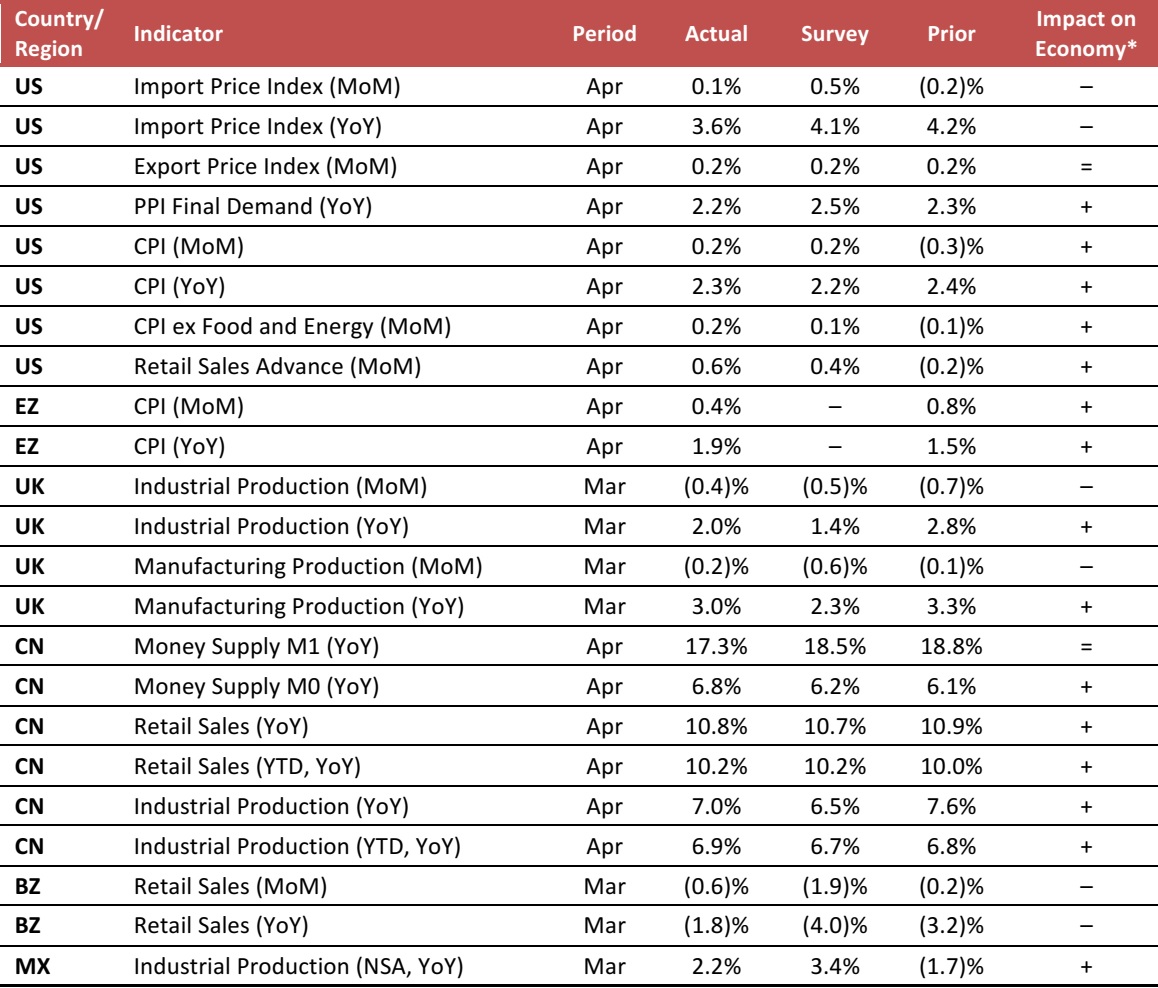
* Fung Global Retail & Technology’s evaluation of the actual figure’s impact on the economy relative to historical benchmarks and the current macroeconomic environment: + indicates a positive signal for the country’s economy, – indicates a negative signal and = indicates a negligible or mixed impact.
Source: US Bureau of Labor Statistics/US Federal Reserve/Markit/Halifax/Eurostat/National Bureau of Statistics of China/Instituto Brasileiro de Geografia e Estatística (IBGE)/Instituto Nacional de Estadística y Geografía (INEGI)/Fung Global Retail & Technology.
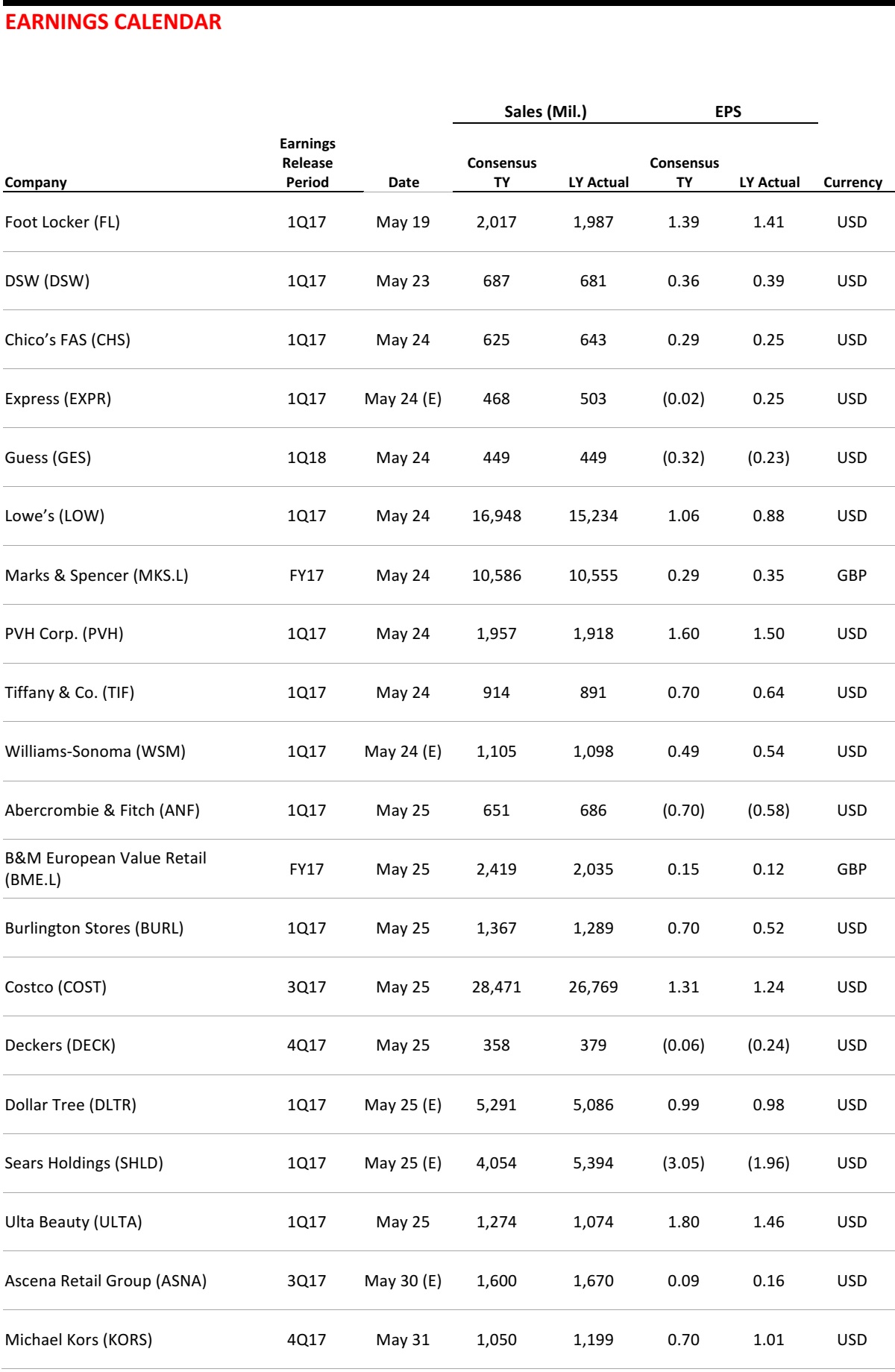
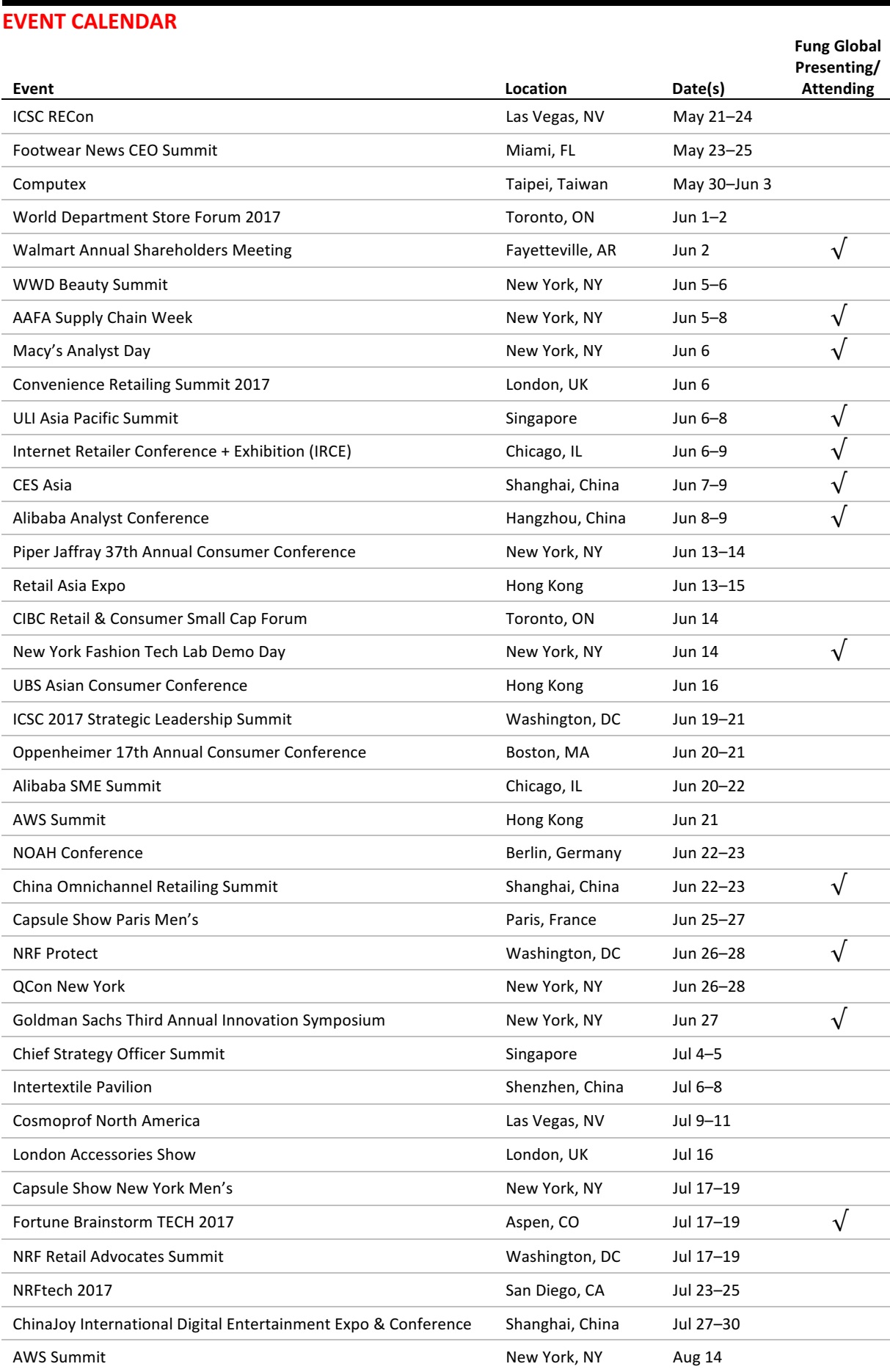





 Here is One of the Few Bright Spots in Retail
(May 16) CNBC.com
Here is One of the Few Bright Spots in Retail
(May 16) CNBC.com
 US Retail Sales Rose by 0.4% in April, Versus a 0.6% Expected Increase
(May 12) CNBC.com
US Retail Sales Rose by 0.4% in April, Versus a 0.6% Expected Increase
(May 12) CNBC.com

 Xiaomi Puts the Focus on India with Plans to Open 100 Retail Stores
(May 12) TechCrunch.com
Xiaomi Puts the Focus on India with Plans to Open 100 Retail Stores
(May 12) TechCrunch.com


